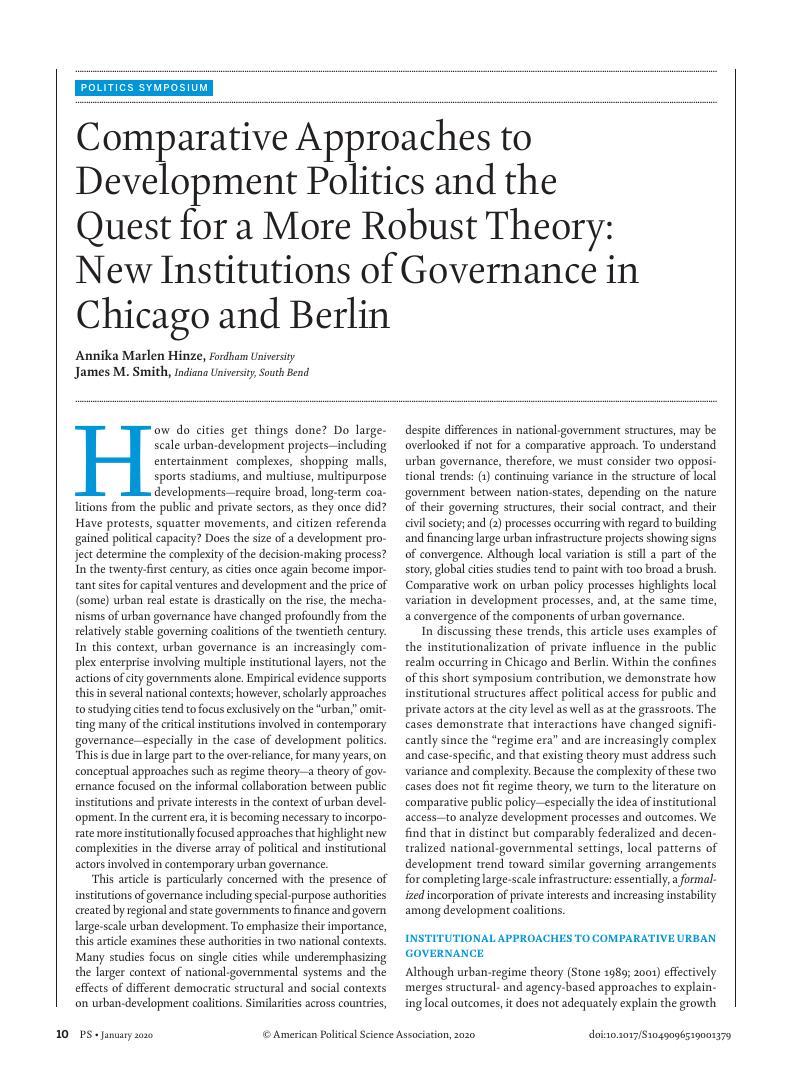No CrossRef data available.
Article contents
Comparative Approaches to Development Politics and the Quest for a More Robust Theory: New Institutions of Governance in Chicago and Berlin
Published online by Cambridge University Press: 23 December 2019
Abstract
An abstract is not available for this content so a preview has been provided. Please use the Get access link above for information on how to access this content.

- Type
- Symposium: Toward an Urban Policy Analysis
- Information
- Copyright
- Copyright © American Political Science Association 2020
References
REFERENCES
Bader, Ingo, and Bialluch, Martin. 2009. “Gentrification and the Creative Class in Berlin-Kreuzberg.” In Whose Urban Renaissance? An International Comparison of Urban Regeneration Strategies, ed. Porter, Libby and Shaw, Kate, 96–99. London: Routledge.Google Scholar
Baumgartner, Frank, and Jones, Bryan D.. 1993. Agendas and Instability in American Politics. Chicago: University of Chicago Press.Google Scholar
Chicago Infrastructure Trust. 2016. “Financial Statements and Independent Auditors’ Report for the Year Ended December 31, 2016.” Available at http://chicagoinfrastructure.org/wp-content/uploads/2013/04/2016-CIT-FS_Audit_Report-FINAL.pdf.Google Scholar
Chicago Infrastructure Trust. 2018. “How it Works.” Available at http://chicagoinfrastructure.org/about/how-it-works.Google Scholar
Die Tageszeitung. 2008. “Bürgerentscheid erfolgreich: Mediaspree ist Ufer los.” taz—Die Tageszeitung, July 13, 2008. https://taz.de/Buergerentscheid-erfolgreich/!5179058/.Google Scholar
Dilworth, Richardson (ed.). 2009. The City in American Political Development. New York: Routledge.10.4324/9780203881101CrossRefGoogle Scholar
Eisinger, Peter K. 1973. “The Conditions of Protest Behavior in American Cities.” American Political Science Review 67 (1): 11–28.10.2307/1958525CrossRefGoogle Scholar
Florida, Richard. 2002. The Rise of the Creative Class...and How It Is Transforming Work, Leisure, Community, and Everyday Life. New York: Basic Books.Google Scholar
Ingram, Helen, and Schneider, Anne L.. 1990. “Improving Implementation through Framing Smarter Statutes.” Journal of Public Policy 10 (1): 66–87.10.1017/S0143814X00004682CrossRefGoogle Scholar
Ingram, Helen, and Schneider, Anne L.. 1991. “The Choice of Target Populations.” Administration and Society 23 (November): 333–56.10.1177/009539979102300304CrossRefGoogle Scholar
Ingram, Helen, Schneider, Anne L., and Deleon, Peter. 2007. “Social Construction and Policy Design.” In Theories of the Policy Process, ed. Sabatier, Paul A., 93–126. Cambridge, MA: Westview Press.Google Scholar
Lowndes, Vivien. 2001. “Rescuing Aunt Sally: Taking Institutional Theory Seriously in Urban Politics.” Urban Studies 38 (11): 1953–71.10.1080/00420980120080871CrossRefGoogle Scholar
Mahoney, Christine. 2007. “Lobbying Success in the United States and the European Union.” Journal of Public Policy 27 (1): 35–56.10.1017/S0143814X07000608CrossRefGoogle Scholar
Mahoney, Christine, and Baumgartner, Frank. 2008. “Converging Perspectives on Interest-Group Research in Europe and America.” West European Politics 31 (6): 1253–73. DOI:10.1080/01402380802372688.10.1080/01402380802372688CrossRefGoogle Scholar
Novy, Johannes, and Colomb, Claire. 2013. “Struggling for the Right to the (Creative) City in Berlin and Hamburg: New Urban Social Movements, New ‘Spaces of Hope’?” International Journal of Urban and Regional Research 37 (5): 1816– 38.10.1111/j.1468-2427.2012.01115.xCrossRefGoogle Scholar
Pierre, Jon. 1999. “Models of Urban Governance: The Institutional Dimension of Urban Politics.” Urban Affairs Review 38 (3): 372–96.10.1177/10780879922183988CrossRefGoogle Scholar
Sapotichne, Joshua, and Smith, James M.. 2012. “Venue Shopping and Urban Development: Lessons from Chicago and Seattle.” Urban Affairs Review 48 (1): 86–110.10.1177/1078087411420373CrossRefGoogle Scholar
Scharenberg, Albert, and Bader, Ingo. 2010. “Berlin’s Waterfront Site Struggle.” City: Analysis of Urban Trends, Culture, Policy, and Action 13 (2–3): 325–35.10.1080/13604810902982938CrossRefGoogle Scholar
Schneider, Anne, and Ingram, Helen. 1988. “Systematically Pinching Ideas: A Comparative Approach to Policy Design.” Journal of Public Policy 8 (1): 61–80.10.1017/S0143814X00006851CrossRefGoogle Scholar
Schneider, Anne, and Ingram, Helen. 1993. “Social Construction of Target Populations: Implications for Politics and Policy.” American Political Science Review 87 (2): 334–347.10.2307/2939044CrossRefGoogle Scholar
Sharp, Elaine B. 1991. “Institutional Manifestations of Accessibility and Urban Economic Development Polity.” Western Political Quarterly 44 (1): 129–47.10.2307/448751CrossRefGoogle Scholar
Smith, James M. 2010. “‘Re-stating’ Theories of Urban Development: The Politics of Authority Creation and Intergovernmental Triads in Post-Industrial Chicago.” Journal of Urban Affairs 32 (4): 425–48.10.1111/j.1467-9906.2010.00497.xCrossRefGoogle Scholar
Stone, Clarence N. 1976. Economic Growth and Neighborhood Discontent. Chapel Hill: University of North Carolina PressGoogle Scholar
Stone, Clarence N. 1989. Regime Politics: Governing Atlanta, 1946–1988. Lawrence: University Press of Kansas.Google Scholar
Stone, Clarence N. 2001. “The Atlanta Experience Re-Examined: The Link between Agenda and Regime Change.” International Journal of Urban and Regional Research 25 (1): 20–34.10.1111/1468-2427.00295CrossRefGoogle Scholar
Stone, Clarence N. 2015. “Reflections on Regime Politics: From Governing Coalition to Urban Political Order.” Urban Affairs Review 51 (1): 101–37.CrossRefGoogle Scholar
Tarrow, Sidney. 1996. “States and Opportunities: The Political Structuring of Social Movements.” In Comparative Perspectives on Social Movements, ed. McAdam, Doug, McCarthy, John D., and Zald, Mayer, 41–61. Cambridge: Cambridge University Press.10.1017/CBO9780511803987.004CrossRefGoogle Scholar
Truman, David. 1951. The Governmental Process: Political Interests and Public Opinion. New York: Alfred A. Knopf.Google Scholar


